Abstract
1. Ten untrained young men ingested a carbohydrate-rich diet (65 energy percent (E%) carbohydrate, T-CHO) and ten similar subjects a fat-rich diet (62 E% fat, T-FAT) while endurance training was performed 3-4 times a week for 7 weeks. For another 8th week of training both groups ingested the carbohydrate-rich diet (T-CHO and T-FAT/CHO). 2. Maximal oxygen uptake increased by 11% (P < 0.05) in both groups after 7 and 8 weeks. Time to exhaustion at 81% of pre-training maximal oxygen uptake increased significantly from a mean (+/- S.E.M.) of 35 +/- 4 min to 102 +/- 5 and 65 +/- 7 min in T-CHO and T-FAT, respectively, after 7 weeks (P < 0.05, T-CHO vs. T-FAT). After 8 weeks, endurance remained unchanged in T-CHO but increased (P < 0.05) to 77 +/- 9 min in T-FAT/CHO which, however, was still less (P < 0.05) than in T-CHO. 3. Muscle glycogen breakdown rate during exercise was halved by endurance training equally in both T-CHO and T-FAT after 7 and 8 weeks, and muscle glycogen stores at exhaustion were not depleted in any group. 4. During exercise after 7 weeks, the respiratory exchange ratio (RER) was unchanged in T-CHO (0.88 +/- 0.01) compared with pre-training but decreased (P < 0.05) to 0.82 +/- 0.02 in T-FAT. After 8 weeks, RER in both T-CHO and T-FAT/CHO was approximately 0.87. 5. During exercise, plasma noradrenaline concentration and heart rate were higher in T-FAT than in T-CHO both at 7 and at 8 weeks. 6. It is concluded that ingesting a fat-rich diet during an endurance training programme is detrimental to improvement in endurance. This is not due to a simple lack of carbohydrate fuel, but rather to suboptimal adaptations that are not remedied by short-term increased carbohydrate availability. Furthermore, the study suggests that the decrease in RER usually seen after training when exercising at the same absolute intensity as before training can be prevented by a carbohydrate-rich diet.
Full text
PDF

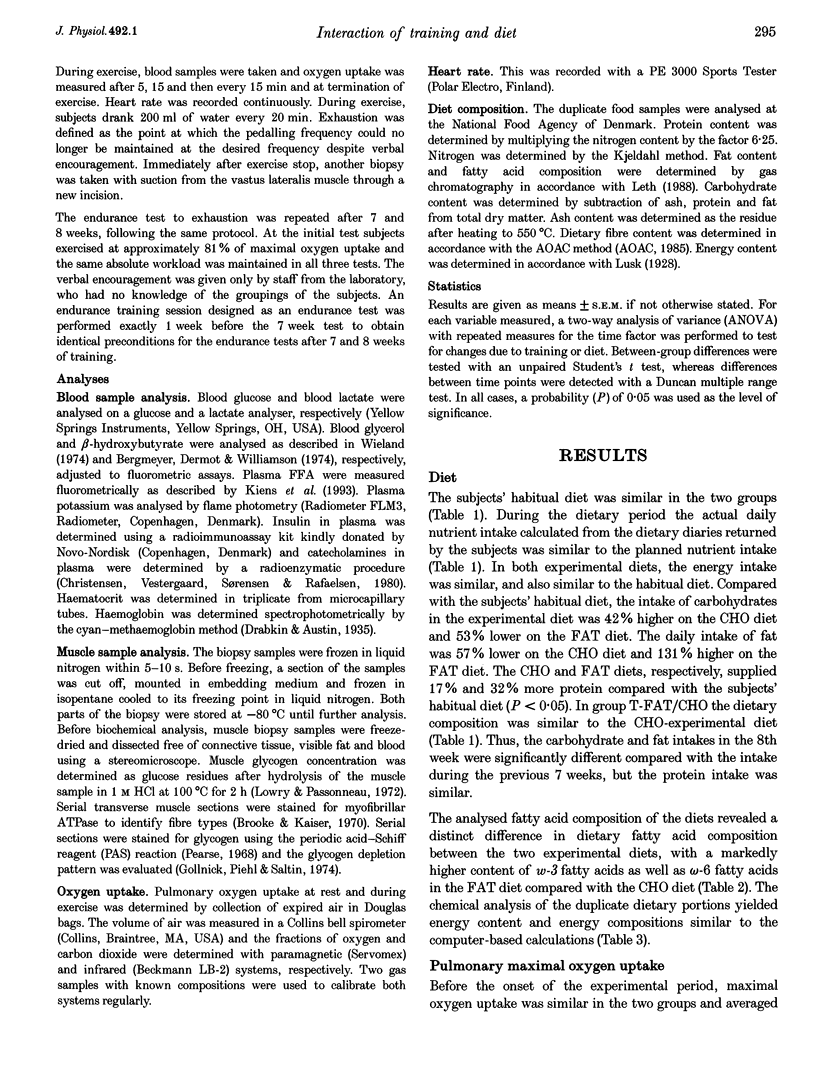



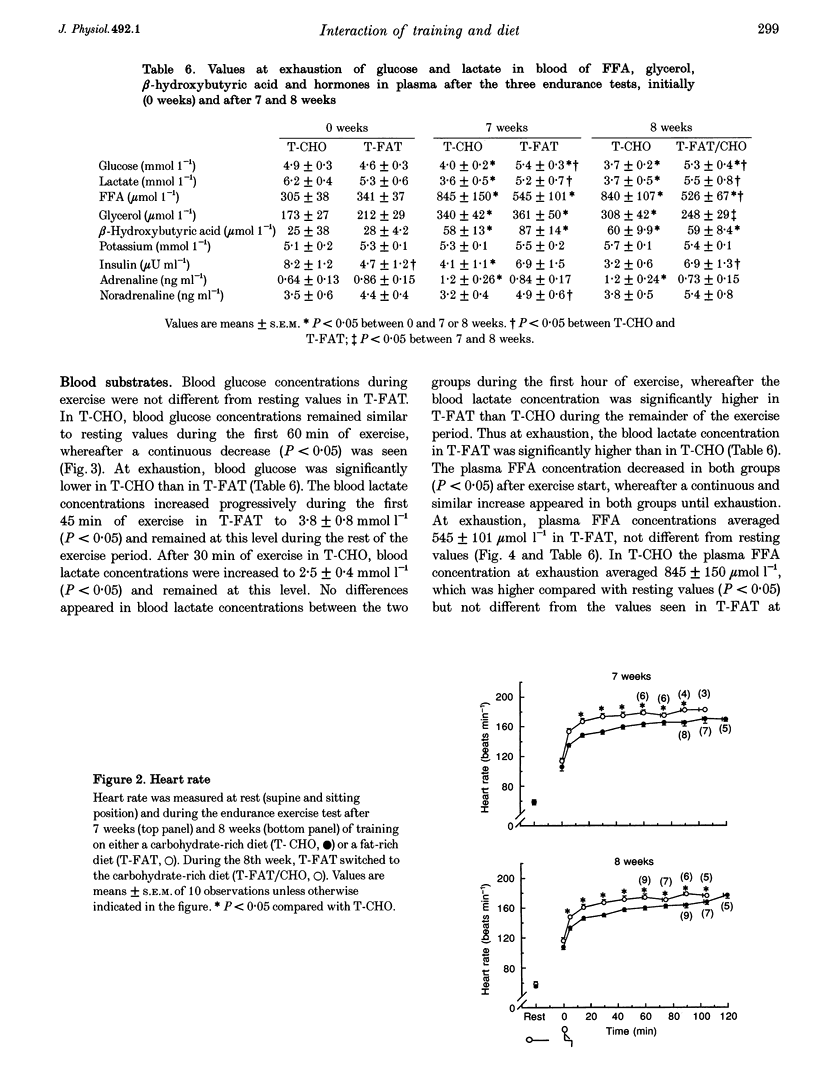
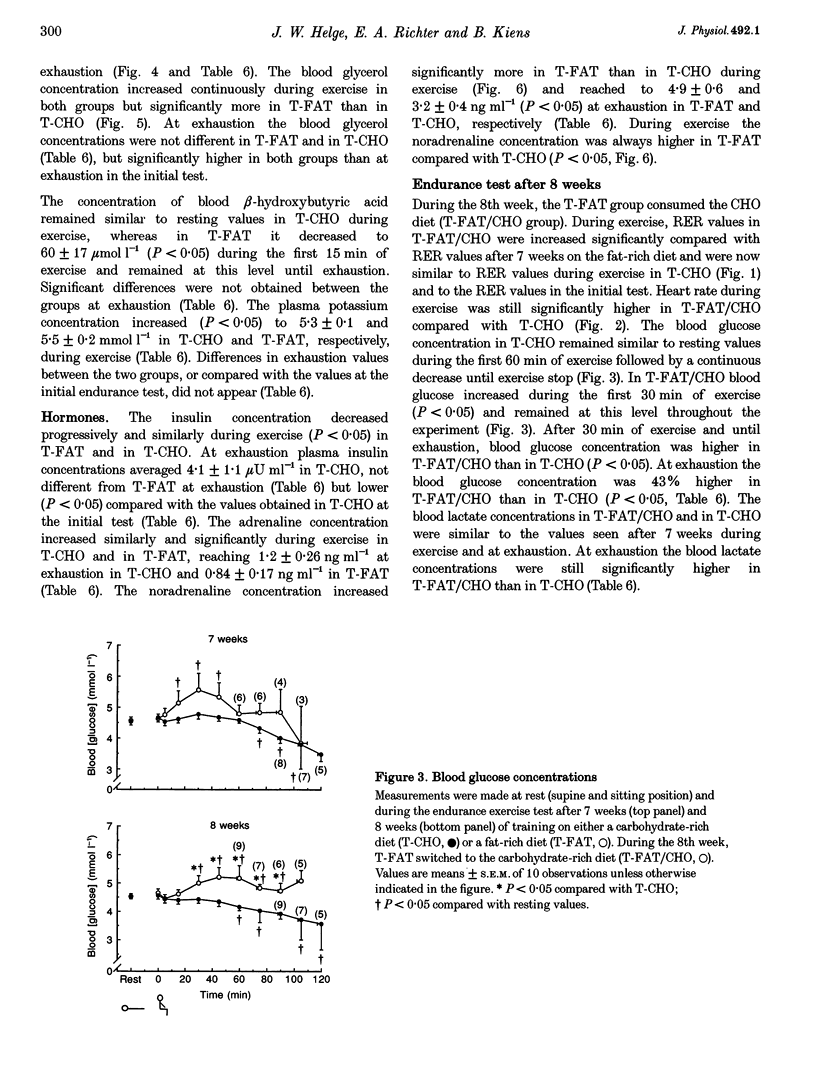



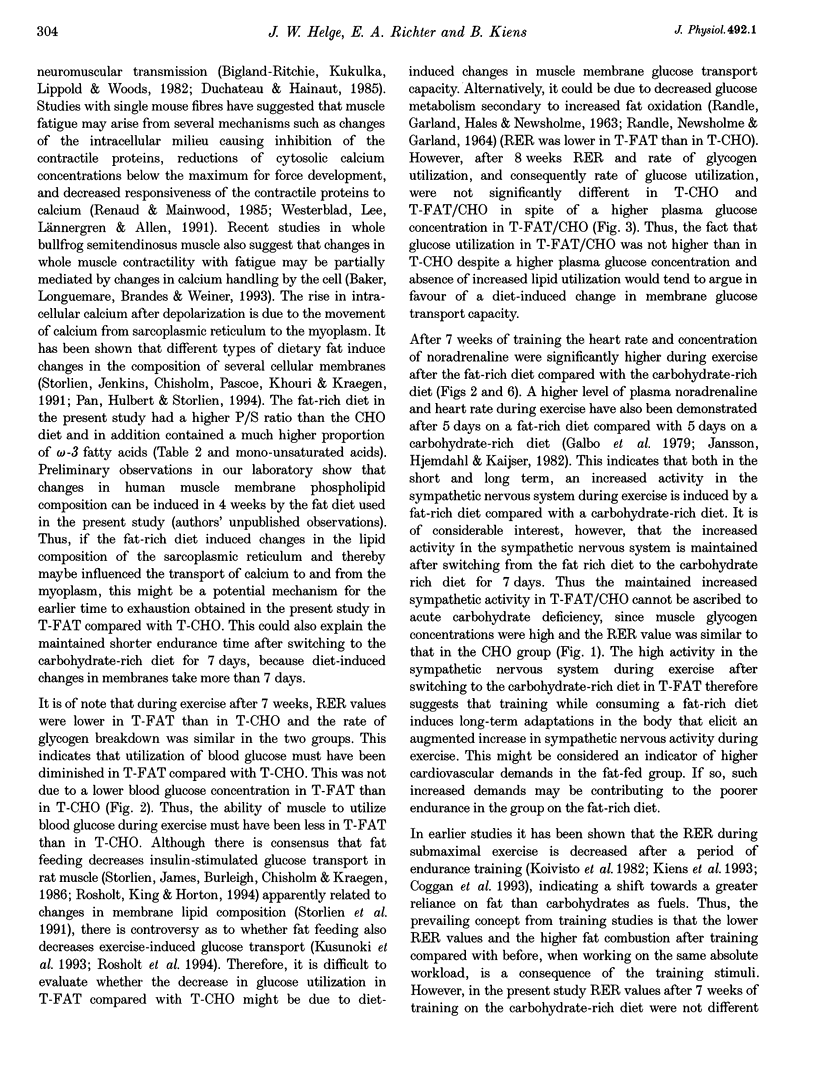
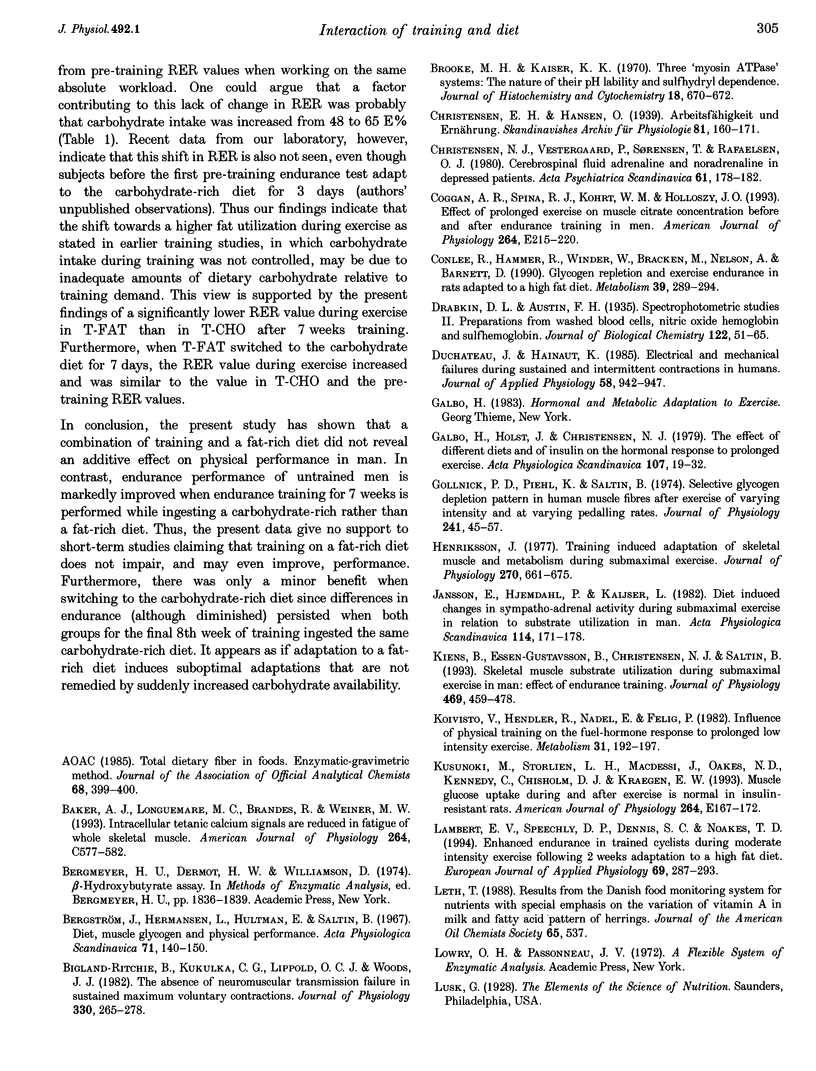
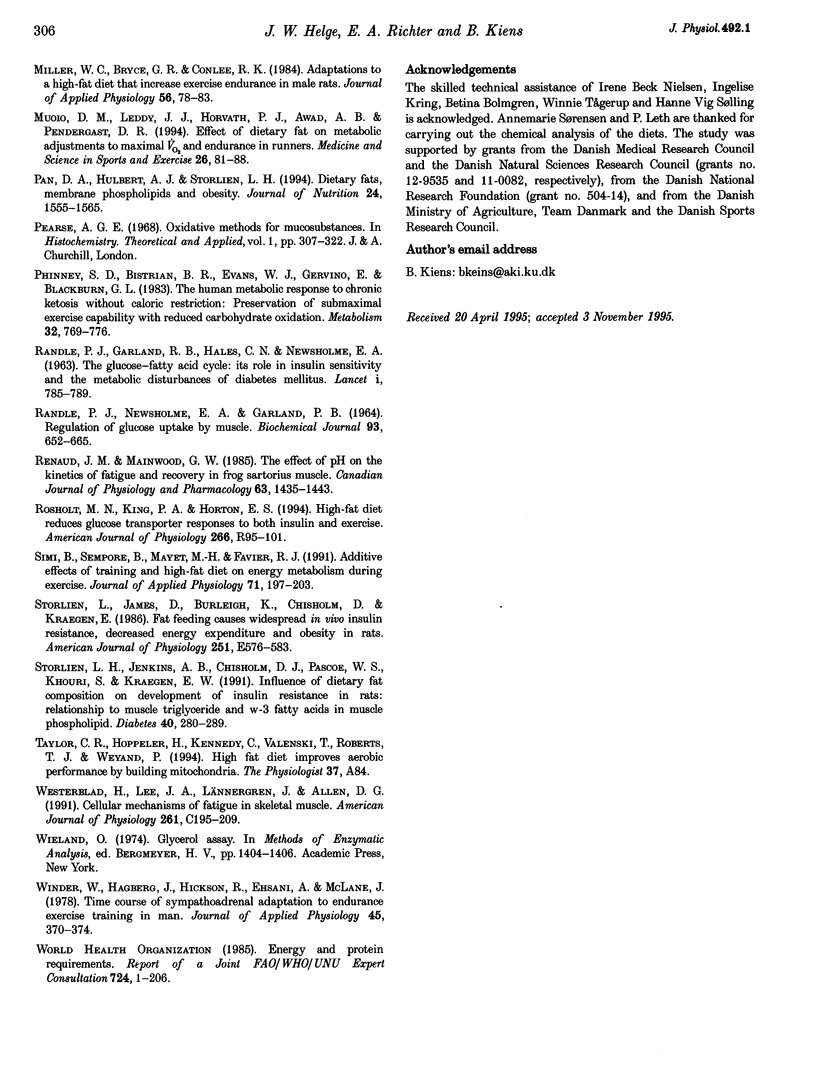
Selected References
These references are in PubMed. This may not be the complete list of references from this article.
- Baker A. J., Longuemare M. C., Brandes R., Weiner M. W. Intracellular tetanic calcium signals are reduced in fatigue of whole skeletal muscle. Am J Physiol. 1993 Mar;264(3 Pt 1):C577–C582. doi: 10.1152/ajpcell.1993.264.3.C577. [DOI] [PubMed] [Google Scholar]
- Bergström J., Hermansen L., Hultman E., Saltin B. Diet, muscle glycogen and physical performance. Acta Physiol Scand. 1967 Oct-Nov;71(2):140–150. doi: 10.1111/j.1748-1716.1967.tb03720.x. [DOI] [PubMed] [Google Scholar]
- Bigland-Ritchie B., Kukulka C. G., Lippold O. C., Woods J. J. The absence of neuromuscular transmission failure in sustained maximal voluntary contractions. J Physiol. 1982 Sep;330:265–278. doi: 10.1113/jphysiol.1982.sp014340. [DOI] [PMC free article] [PubMed] [Google Scholar]
- Brooke M. H., Kaiser K. K. Three "myosin adenosine triphosphatase" systems: the nature of their pH lability and sulfhydryl dependence. J Histochem Cytochem. 1970 Sep;18(9):670–672. doi: 10.1177/18.9.670. [DOI] [PubMed] [Google Scholar]
- Christensen N. J., Vestergaard P., Sørensen T., Rafaelsen O. J. Cerebrospinal fluid adrenaline and noradrenaline in depressed patients. Acta Psychiatr Scand. 1980 Feb;61(2):178–182. doi: 10.1111/j.1600-0447.1980.tb00577.x. [DOI] [PubMed] [Google Scholar]
- Coggan A. R., Spina R. J., Kohrt W. M., Holloszy J. O. Effect of prolonged exercise on muscle citrate concentration before and after endurance training in men. Am J Physiol. 1993 Feb;264(2 Pt 1):E215–E220. doi: 10.1152/ajpendo.1993.264.2.E215. [DOI] [PubMed] [Google Scholar]
- Conlee R. K., Hammer R. L., Winder W. W., Bracken M. L., Nelson A. G., Barnett D. W. Glycogen repletion and exercise endurance in rats adapted to a high fat diet. Metabolism. 1990 Mar;39(3):289–294. doi: 10.1016/0026-0495(90)90049-i. [DOI] [PubMed] [Google Scholar]
- Duchateau J., Hainaut K. Electrical and mechanical failures during sustained and intermittent contractions in humans. J Appl Physiol (1985) 1985 Mar;58(3):942–947. doi: 10.1152/jappl.1985.58.3.942. [DOI] [PubMed] [Google Scholar]
- Galbo H., Holst J. J., Christensen N. J. The effect of different diets and of insulin on the hormonal response to prolonged exercise. Acta Physiol Scand. 1979 Sep;107(1):19–32. doi: 10.1111/j.1748-1716.1979.tb06438.x. [DOI] [PubMed] [Google Scholar]
- Gollnick P. D., Piehl K., Saltin B. Selective glycogen depletion pattern in human muscle fibres after exercise of varying intensity and at varying pedalling rates. J Physiol. 1974 Aug;241(1):45–57. doi: 10.1113/jphysiol.1974.sp010639. [DOI] [PMC free article] [PubMed] [Google Scholar]
- Henriksson J. Training induced adaptation of skeletal muscle and metabolism during submaximal exercise. J Physiol. 1977 Sep;270(3):661–675. doi: 10.1113/jphysiol.1977.sp011974. [DOI] [PMC free article] [PubMed] [Google Scholar]
- Jansson E., Hjemdahl P., Kaijser L. Diet induced changes in sympatho-adrenal activity during submaximal exercise in relation to substrate utilization in man. Acta Physiol Scand. 1982 Feb;114(2):171–178. doi: 10.1111/j.1748-1716.1982.tb06969.x. [DOI] [PubMed] [Google Scholar]
- Kiens B., Essen-Gustavsson B., Christensen N. J., Saltin B. Skeletal muscle substrate utilization during submaximal exercise in man: effect of endurance training. J Physiol. 1993 Sep;469:459–478. doi: 10.1113/jphysiol.1993.sp019823. [DOI] [PMC free article] [PubMed] [Google Scholar]
- Koivisto V., Hendler R., Nadel E., Felig P. Influence of physical training on the fuel-hormone response to prolonged low intensity exercise. Metabolism. 1982 Feb;31(2):192–197. doi: 10.1016/0026-0495(82)90135-4. [DOI] [PubMed] [Google Scholar]
- Kusunoki M., Storlien L. H., MacDessi J., Oakes N. D., Kennedy C., Chisholm D. J., Kraegen E. W. Muscle glucose uptake during and after exercise is normal in insulin-resistant rats. Am J Physiol. 1993 Feb;264(2 Pt 1):E167–E172. doi: 10.1152/ajpendo.1993.264.2.E167. [DOI] [PubMed] [Google Scholar]
- Lambert E. V., Speechly D. P., Dennis S. C., Noakes T. D. Enhanced endurance in trained cyclists during moderate intensity exercise following 2 weeks adaptation to a high fat diet. Eur J Appl Physiol Occup Physiol. 1994;69(4):287–293. doi: 10.1007/BF00392032. [DOI] [PubMed] [Google Scholar]
- Miller W. C., Bryce G. R., Conlee R. K. Adaptations to a high-fat diet that increase exercise endurance in male rats. J Appl Physiol Respir Environ Exerc Physiol. 1984 Jan;56(1):78–83. doi: 10.1152/jappl.1984.56.1.78. [DOI] [PubMed] [Google Scholar]
- Muoio D. M., Leddy J. J., Horvath P. J., Awad A. B., Pendergast D. R. Effect of dietary fat on metabolic adjustments to maximal VO2 and endurance in runners. Med Sci Sports Exerc. 1994 Jan;26(1):81–88. [PubMed] [Google Scholar]
- Pan D. A., Hulbert A. J., Storlien L. H. Dietary fats, membrane phospholipids and obesity. J Nutr. 1994 Sep;124(9):1555–1565. doi: 10.1093/jn/124.9.1555. [DOI] [PubMed] [Google Scholar]
- Phinney S. D., Bistrian B. R., Evans W. J., Gervino E., Blackburn G. L. The human metabolic response to chronic ketosis without caloric restriction: preservation of submaximal exercise capability with reduced carbohydrate oxidation. Metabolism. 1983 Aug;32(8):769–776. doi: 10.1016/0026-0495(83)90106-3. [DOI] [PubMed] [Google Scholar]
- RANDLE P. J., GARLAND P. B., HALES C. N., NEWSHOLME E. A. The glucose fatty-acid cycle. Its role in insulin sensitivity and the metabolic disturbances of diabetes mellitus. Lancet. 1963 Apr 13;1(7285):785–789. doi: 10.1016/s0140-6736(63)91500-9. [DOI] [PubMed] [Google Scholar]
- Randle P. J., Newsholme E. A., Garland P. B. Regulation of glucose uptake by muscle. 8. Effects of fatty acids, ketone bodies and pyruvate, and of alloxan-diabetes and starvation, on the uptake and metabolic fate of glucose in rat heart and diaphragm muscles. Biochem J. 1964 Dec;93(3):652–665. doi: 10.1042/bj0930652. [DOI] [PMC free article] [PubMed] [Google Scholar]
- Renaud J. M., Mainwood G. W. The effects of pH on the kinetics of fatigue and recovery in frog sartorius muscle. Can J Physiol Pharmacol. 1985 Nov;63(11):1435–1443. doi: 10.1139/y85-236. [DOI] [PubMed] [Google Scholar]
- Rosholt M. N., King P. A., Horton E. S. High-fat diet reduces glucose transporter responses to both insulin and exercise. Am J Physiol. 1994 Jan;266(1 Pt 2):R95–101. doi: 10.1152/ajpregu.1994.266.1.R95. [DOI] [PubMed] [Google Scholar]
- Storlien L. H., James D. E., Burleigh K. M., Chisholm D. J., Kraegen E. W. Fat feeding causes widespread in vivo insulin resistance, decreased energy expenditure, and obesity in rats. Am J Physiol. 1986 Nov;251(5 Pt 1):E576–E583. doi: 10.1152/ajpendo.1986.251.5.E576. [DOI] [PubMed] [Google Scholar]
- Storlien L. H., Jenkins A. B., Chisholm D. J., Pascoe W. S., Khouri S., Kraegen E. W. Influence of dietary fat composition on development of insulin resistance in rats. Relationship to muscle triglyceride and omega-3 fatty acids in muscle phospholipid. Diabetes. 1991 Feb;40(2):280–289. doi: 10.2337/diab.40.2.280. [DOI] [PubMed] [Google Scholar]
- Westerblad H., Lee J. A., Lännergren J., Allen D. G. Cellular mechanisms of fatigue in skeletal muscle. Am J Physiol. 1991 Aug;261(2 Pt 1):C195–C209. doi: 10.1152/ajpcell.1991.261.2.C195. [DOI] [PubMed] [Google Scholar]
- Winder W. W., Hagberg J. M., Hickson R. C., Ehsani A. A., McLane J. A. Time course of sympathoadrenal adaptation to endurance exercise training in man. J Appl Physiol Respir Environ Exerc Physiol. 1978 Sep;45(3):370–374. doi: 10.1152/jappl.1978.45.3.370. [DOI] [PubMed] [Google Scholar]


